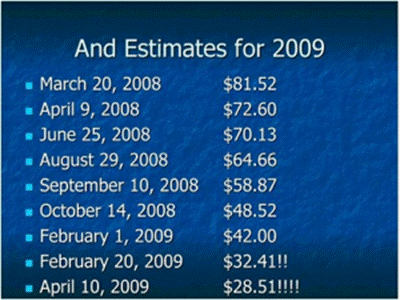The One Thing You Need to Know About Dividend Investing Today
InvestorEducation / Dividends Jun 02, 2009 - 02:58 AM GMTBy: Graham_Summers
 Dividend investing may be dead… at least for now.
Dividend investing may be dead… at least for now.
For a company to pay out dividends, it has to make money (the one exception to this is the financial sector which now resorts to using government money or simply issuing more shares in order to maintain dividend payments).
When times are good, this means that a “buy and hold” strategy can result in yields far, FAR greater than the company’s listed payouts. For instance, let’s say you buy shares of ABC company at $10 a share yielding 10% (a dividend payout of $1.00). Now, if ABC increases its dividend by just 5% a year, within ten years you’re collecting a 16% yield ($1.62 per year on your original buy price of $10).
Thus even if ABC’s listed yield remains 10%, you’re actually collecting 16% a year. Pretty sweet, right?
But what happens if ABC company starts making a lot LESS money? Let’s say the economy goes in the dumps (like today). Or even worse, let’s say consumer spending habits undergo a seismic shift resulting in FAR less shopping and sales (also like today).
Welcome to dividend investing today:

Source: John Mauldin, Millennium Wave Advisors
The above table shows expected 2009 earnings for the S&P 500 starting in March 2008. As you can see, over the last year, analysts have lowered their earnings estimates dramatically (that’s putting it mildly).
According to Bloomberg, 288 companies cut or suspended payouts at the end of 2008. That’s the largest drop since Standard & Poor’s (S&P) records began 54 years ago. In fact, predictions based on dividends show shares today are overvalued by more than 46 percent.
All told, the reduction in dividend payouts at the end of 2008 exceeded ALL reduction for the years 2003-2007 COMBINED. Companies listed on the S&P 500 are expected to trim payouts by an additional 13% this year: the largest drop since 1942.
If you’re looking to invest based on a company’s dividend payouts, think again. That yield you’re looking at may in fact be a mirage. And when the company cuts its payouts, share prices will plummet.
My advice: take a long hard look at the company’s financial statements. Can the company continue to meet dividend payments even if earnings fall another 20%? How quickly did sales evaporate during 2008? Has the company already cut its dividend payouts in the last 12 months? If so, by how much?
It’s also worth considering how far back the company’s dividend payouts go. Did the company maintain dividends during the last major recessions (early ‘90s, early ‘80s, etc)? If so, you might have a good chance of getting a decent return during this downturn.
To return to my original thesis: companies need to make money to continue their payouts. With earnings falling off a cliff, dividends will be cut, and dividend investing will be a LOT harder. So make sure you do your homework before investing based on yield.
Speaking of which, I’ve put together a FREE Special Report on one of the biggest dividend payouts in the market today. Run by one of the richest men in the world, this investment is legally obligated to pay out 90% of its earnings to shareholders. So there’s little chance of its dividend being cut.
Currently this investment yields 9%. It’s raised its dividend every year for the last 10 years. You can learn all about it in my FREE Special Report The Billionaire’s CD: Where the Super-Rich Park Their Cash and Collect an 8% Yield. Swing by www.gainspainscapital.com today to pick up a FREE copy today.
Graham Summers
Graham Summers: Graham is Senior Market Strategist at OmniSans Research. He is co-editor of Gain, Pains, and Capital, OmniSans Research’s FREE daily e-letter covering the equity, commodity, currency, and real estate markets.
Graham also writes Private Wealth Advisory, a monthly investment advisory focusing on the most lucrative investment opportunities the financial markets have to offer. Graham understands the big picture from both a macro-economic and capital in/outflow perspective. He translates his understanding into finding trends and undervalued investment opportunities months before the markets catch on: the Private Wealth Advisory portfolio has outperformed the S&P 500 three of the last five years, including a 7% return in 2008 vs. a 37% loss for the S&P 500.
Previously, Graham worked as a Senior Financial Analyst covering global markets for several investment firms in the Mid-Atlantic region. He’s lived and performed research in Europe, Asia, the Middle East, and the United States.
© 2009 Copyright Graham Summers - All Rights Reserved
Disclaimer: The above is a matter of opinion provided for general information purposes only and is not intended as investment advice. Information and analysis above are derived from sources and utilising methods believed to be reliable, but we cannot accept responsibility for any losses you may incur as a result of this analysis. Individuals should consult with their personal financial advisors.
Graham Summers Archive |
© 2005-2022 http://www.MarketOracle.co.uk - The Market Oracle is a FREE Daily Financial Markets Analysis & Forecasting online publication.



